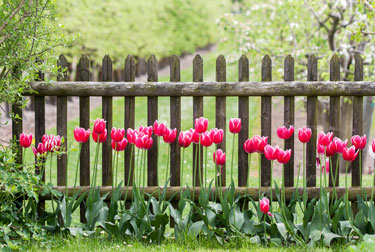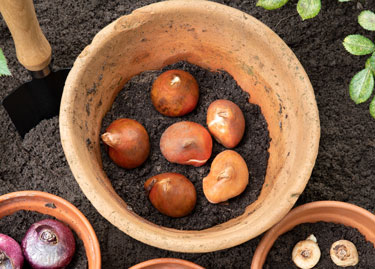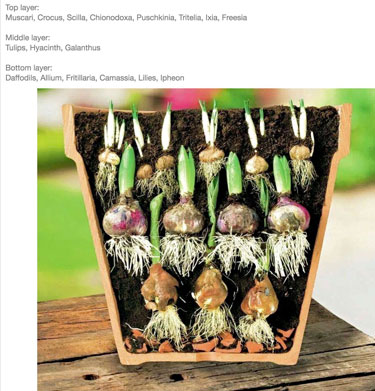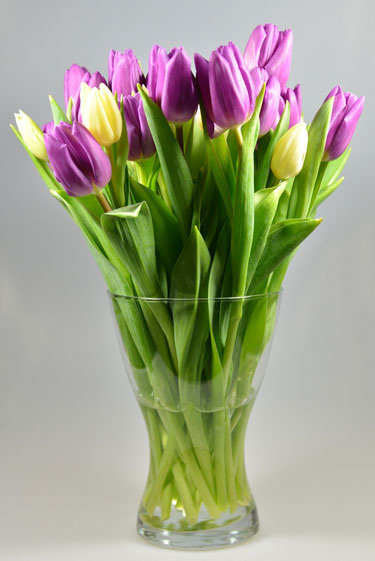Grow tulips
While technically perennial, most tulip varieties bloom reliably for only one year due to years of selective breeding to get the most beautiful flowers. For consistently good displays, plant new bulbs each autumn, especially when growing tulips in pots.
Plant the bulbs in late autumn when soil temperatures are cooler, ideally below 12°C, between May and July. Tulips love a cooler climate but Darwin hybrid tulips and species tulips will do well in warmer areas. Chilling the bulbs in the fridge for at least 6 weeks before planting will replicate winter chilling, prolonging their flowering. Place the bulbs in a paper bag, in the centre of the fridge where they won’t freeze, and away from ripening fruit (the ethylene released by fruit can damage the developing tulip buds).
Planting a range of tulip varieties extends the flowering time, while planting many of the same variety will create an impressive display.
Where to plant
Tulips do best in sunny, sheltered locations with well-drained soil. Improve heavy clay or sandy soils with the addition of plenty of compost before planting. Planting tulips between perennials in a border can be effective, as the emerging foliage of the perennials will hide the leaves of the tulips as they die back.
How to plant
Dig a planting hole with a garden trowel or bulb planter, adding a small measure of bulb fertiliser. Drop the bulb into the hole with the pointed end up. Plant around 10cm deep in cool regions and 15cm in warmer areas, and up to 10cm apart. For the best display, plant tulips en masse.
Tulips grow very well in pots, but these need replanting fresh each year. Half-fill the container with quality potting mix or bulb mix. Plant the bulbs at three times their depth, with a few millimetres between each one to get as many in the pot for the biggest impact. Top up with the potting mix.
You can also combine tulips with other spring bulbs in a container for a more long-lasting display, by planting in layers. Larger bulbs fill the deeper layers, with smaller bulbs sitting above them.
After care
Feed the plants with bulb food when leaves and buds appear, and again after flowering. This ensures the bulbs have the nutrients needed for new flowers next year.
Tulips can stay in the soil year-round for reflowering the following year. But to get the best flowering, it is important to allow the leaves to transfer as much energy as possible back to the bulbs.
After flowering, remove the deadheads to prevent energy being used to produce seeds. Wait to cut back the foliage until it turns yellow, usually about six weeks after flowering. Cutting back the foliage too early could result in weaker bulbs the next year.
Tulips are more likely to reflower in cooler regions; in warm areas, replanting with new bulbs is best.
Tips for keeping tulips looking good in a vase
For the longest vase life:
- Cut the tulips when the buds are just starting to open - the colour of the flower should be visible.
- Before arranging them in the vase, condition the stems by re-cutting the base at an angle with a clean sharp knife, at least 2cm from the bottom of the stem. This will increase the flower's water uptake so they stay fresh and don't wilt.
- Cut flower food is not necessary but tulips are extremely thirsty. For the longest vase life, keep the vase full of fresh water, change the water daily. At the very least, top off the water as the level lowers.
- Keep your tulips in a cool room. You can even drop an ice cube in the water to help keep the temperature down. (You can do this with tulips grown in pots too. It will help them stay in bloom longer indoors.)
- Keep your cut tulips away from sources of heat, including direct sunlight, heaters, lamps, television sets, and other electronics.
- Do not mix daffodils and tulips in a vase as the daffodils exude a substance that can prevent tulips from taking up water.
With proper care, tulips should last about seven days after opening.

24-Mar-2025

Tulips on a fence

Planting tulip bulbs in a pot

A bulb 'lasagne' - layers of bulbs planted in a pot


